Chapter 1. Kimono historically
Kimono is a native garment of the japanese. It's a T-shaped robe with big sleeves. In her book Kimono - Fashioning Culture Liza Dalby opens the word kimono, ki: To wear and mono: Thing. So lingvistically kimono means a thing to wear.
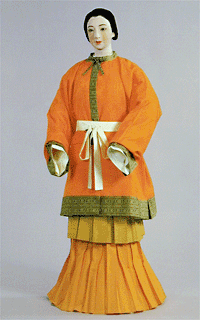 | |
| Court lady of the Suiko Dynasty. |
Kimono originates from China and the earliest kimonos were heavily influenced by the Han chinese clothing, nowadays known as hanfu. In the clothes from the Asuka-Nara periods (538-794 AC) the clothes still have rounded necklines and a two piece combination of a skirt and shirt. In the pleating of the skirts can be seen the beginnings of the hakama.
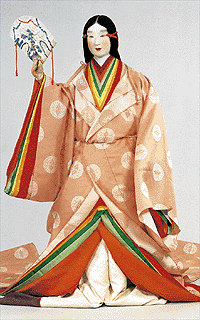 |
| Young girl in heian court dress. |
 |
| Empress Shouken 1872. |
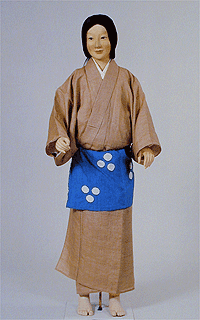 |
| Woman in kosode and an apron. |
During the Kamakura period (1192-1333) the layers grew less and less until people dressed solely on the kosode, that in the Heian period had been considered an underwear. The hakama, that had been worn over the kosode was discarded and the place for the obi to held the kosode closed was born. The obi was still only a string.
Kosode, small sleeve, got it's name from it's small sleeves. These kimonos were made to fit, so there was no ohashori on the waist and hips. The sleeve was small enough to be set on the whole onto the kimono body.
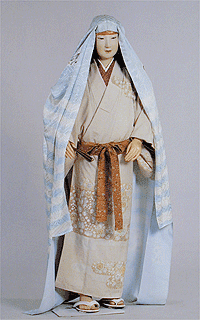 |
| Woman wearing an uchikake on her head. |
During the Kamakura period the usage of uchikake as an outer layer was very diverse. For instance, a woman of the warrior class could place one on her head and shade from rain or hard sunshine. One could also dress it normally over the kosode or wrap it around her waist and let the top part hang loose.
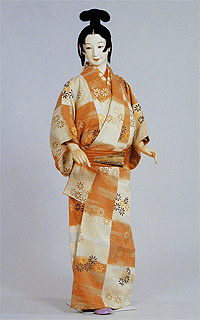 |
| Courtesan of the Muromachi period. |
Towards the end the Muromachi period (1339-1573) the portuguese accidently made land in japanese soil and introduces fire arms to the japanese. During the Azuchi-Momoyama period (1568-1603) more traders from the Netherlands, Spain, England and Portugal arrived with jesuit, dominican and fransiscan missionaries. Their strange clothing was something complitety new to the japanese and some tried to adapt these strange styles into the japanese fashion, like the ruff.
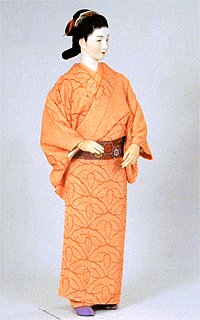 |
| Woman in early Edo period. |
Edo period (1603-1868) can be seen as the Rise of the Obi. During this period the obi developed from the widht of a palm onto it's current measurements. Because of this development the obi could no longer be tied to the front and the knot was moved onto the back. Only courtesans kept the habit of tying their obi to the front and this became the "trade mark" of a woman of easy virtue. During this time the art of tying your obi in different styles was begun. The knots were soft and the part around quite wrinkly, the stiffeners were not invented yet. As the obi grew, it started to need it's own accessories when worn, which meant the birth of obijime and obiage.
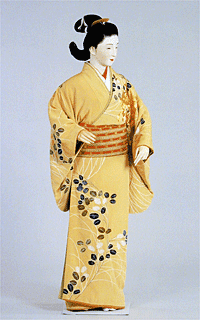 |
| Woman in the middle of Edo period. |
The kimono in the Edo period grew in lenght, both the hem and the sleeves. Soon the sleeves were too long to stay attached to the body of the kimono and they separated from the bottom leaving only the shoulder seam to attach them into the kimono. This allowed free growth to the sleeve and the obi. The hem of the kimono started trailing on the ground. The difference between a kosode in the early Edo and modern kimono can be viewed from the next image.
Kosode is more square in shape as the kimono is rectangular. The sleeves became wider as the body of the kimono became tighter and the collar set to it's current shape.
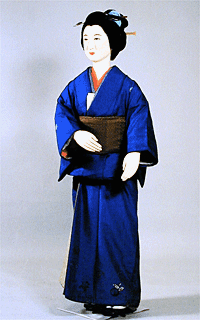 |
| Young married woman in kosode. |
When westerners asked what the strange clothing the japanese wore during the Meiji period (1868-1912), the japanese answered "Something to wear" (Kimono) which included all clothing a person could wear. Until the arrival of the western clothing (yofuku) the kosode had no rivals, but as the yofuku gained footage on the japanese soil, the japanese had to figure out a name for their traditional clothing as the current shape of the kosode no longer a "small sleeve". This lead to the standardizing of the kimono as the main term used on this T-shaped japanese garment and under it came the different types of the kimono.
 |
| Tissot, A woman in japanese bath. |
Just as western fashions were influencing the start of decline in kimono, all things japanese became "the thing" in the west. Japonisme as a term was first used in 1872 and it influenced the Art Nouveau and cubic art movements as well as fashion through woodblock prints brought to the west. Which followed by the silk kimonos being shipped to be house robes for the western ladies.
After the Meiji period the kimono was not allowed to trail again, but was hiked up to a fold on the hips known as the ohashori with a shash or a cord. The basic shape of a kimono did not change again but was standardized. The only change has become on the lenght of your standard kimono lenght as the avaridge hight of women has grown since then.
The patterns and colord have changed over the ages and are changing even now, but I'll write about them in the next chapter. This chapter was to show you the transition of the Asuka dress into the modern kimono shape.
Images:
The Costume Museum
Empress Shouken
Jacques-Joseph Tissot, A Woman in Japanese Bath
Reference:
Costume museum
Liza Dalby, Kimono - Fashioning culture
Women's kimono, kanzashi & accessories
The Book of Kimono
I hope I didn't make any blundant mistakes.... I hope you enjoyed reading!
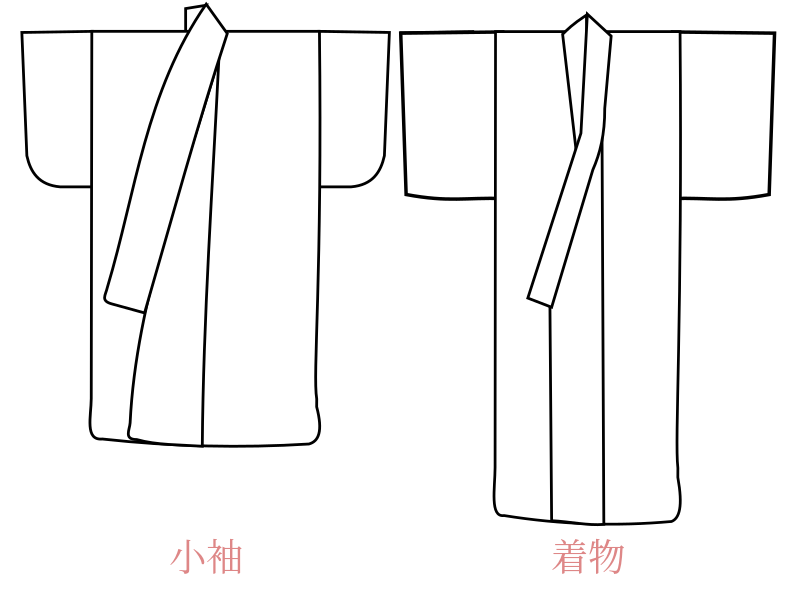
Thank you, this was an interesting read. =)
VastaaPoista